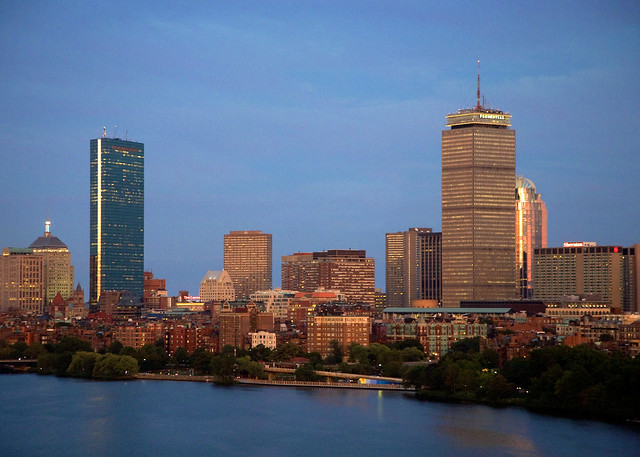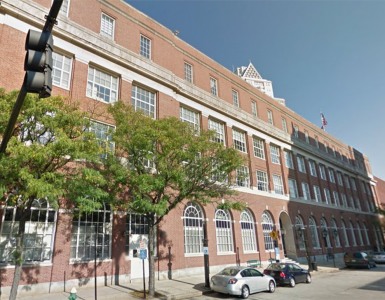Boston at Dusk. Photo (cc) David Fox for Massachusetts Office of Travel & Tourism
Bloomberg: Boston Booms as Workers Say No to Suburbs: Real Estate
“In the last 24 months, suburban tech firms have been looking to relocate into town,” said Andrew Hoar, president and co-managing partner at CBRE/New England, a joint venture partner with CBRE. “For many other markets it’s the other way around. The young graduates in this town don’t want to commute.”
The Atlantic Cities: The End of Federal Transportation Funding as We Know It
This month marks 120 years since the federal government got involved in funding road transportation. (Strange as it sounds, bicycle advocates did the bulk of the lobbying.) The original Office of Road Inquiry — today, the Federal Highway Administration — was a line item with a budget of $10,000. That was only enough money to build about three miles of road, and the office wasn’t empowered to build roads anyway, but states fought tooth and nail against giving the feds even this incredibly modest level of transport oversight.
Today the federal transportation program faces perhaps its greatest challenge since that shaky start. The most urgent problem is funding. The Highway Trust Fund that pays for America’s road and rail program is heading straight toward bankruptcy. For two decades politicians have refused to raise the 18.4-cents-per-gallon gas tax that populates the trust, even as it steadily loses purchasing power to inflation and fuel-efficient cars. The public has yet to embrace alternative funding sources — road fares or mileage fees on the user-pay side favored by economists; income taxes on the social welfare end — in part because people (mistakenly) believe they already pay a lot for transportation.
More on the possible shift from federal to local funding for transportation:
The Transport Politic: A Renewed Look at Federal Funding for Transit Operations
The federal transportation program is at a crossroads. Congress is apparently incapable of advancing new or expanded funding for roads and transit, and has even passed legislation cutting back on previously approved appropriations.
The stalemate has left academics and commentators grasping about for a solution. Some, as Eric Jaffe profiled in an article this week, suggest that a decline in Washington’s role in funding transportation infrastructure may lead to better decisions by states and localities about how to invest; too many projects, they argue, are poorly designed or executed, in part because of federal sway.
Missing from this conversation, however, is the arguably more important issue of how transit operations should be funded. While America’s infrastructure is deteriorating, the most important question for the large majority of the nation’s public transportation users (or potential users) is how often a bus will show up nearby and whether it will take them efficiently to employment or other destinations. While the federal government currently chips in for new vehicles, it rarely spends much of its own money on hiring drivers and paying for fuel (though it chipped in until the 1980s); most of those expenses are covered by passenger fares and subsidies from state and local governments.
But should Washington be more involved?
ecoRI News: Planning to Make Providence a Bike-Friendly City
The city is developing Bike Providence, a bicycle master plan, and is seeking public input. With funding from a state Planning Challenge grant, consultants from the local office of Vanasse Hangen Brustlin Inc. (VHB), a steering committee and city staff have generated data and input on preferred routes, held a public workshop, and addressed the need for education and culture change in adapting our infrastructure and habits to a more bike-friendly city.
The Plain Dealer: Cleveland is slowly becoming a more bike- and pedestrian-friendly town
From the 1970s through the early 2000s, the city and various partners fought to save downtown by renovating the historic theaters at PlayhouseSquare and building attractions such as the Gateway sports complex, Cleveland Browns Stadium and the Rock and Roll Hall of Fame and Museum.
Streetscapes and parks received little attention back then. The result: a downtown with great attractions and beautiful historic buildings separated by garages, surface-parking dead zones and acres of concrete that discouraged walking and cycling.
Now, as it tries to attract more visitors and increase the number of downtown residents from today’s 11,700, the city recognizes that creating attractive public spaces and bike-friendly streets is essential, not a frill.







“Boston Booms as Workers Say No to Suburbs: Real Estate”
There are a number of components to Boston’s current office boom, including the mix of universities with the graduates that they produce, compactness and the livability of the city, and the critical mass of life science and tech industries. What wasn’t mentioned in this Bloomberg video is the transportation that ties Boston’s office districts together, which is the T and in particular the Red Line that makes the boom possible. The Red Line is the primary transportation spine that links the long linear corridor that has experienced recent rapid growth.
Red Line Station – Office Vacancy Rates
(CBRE/New England from 2012)
Alewife: 17.1%
Porter/Davis: 6.7%
Harvard: 2.1%
Central: 6.4%
Kendall: 5.8%
Downtown Crossing: 16.8%
South Station: 15.6%
Does the I-195 Redevelopment Commission, the City, and the State understand that the incredible recent success of the Boston-Cambridge area has to a great degree been due to its rail mass transit? It will be a tremendous mass transit improvement when RIPTA’s launches its R-Line rapid bus route with its 29 stations next year, but it’s unfortunate that the R-Line won’t go to all the places that it needs to.
The R-Line will connect the Train Station/Capital Center, the Financial District, Downcity, and the Empire office area, but will avoid College Hill, the 195-land, the Jewelry District, and the South Providence hospitals. That probably translates to the R-Line missing about 25,000 employees and students, plus 10,000 residents of an approximate total of 68,000 people who work, study, or live in the core of the Downtown-College Hill-South Providence area.
If the City and State are serious about developing or expanding the so-called “Knowledge Economy,” officials should revisit and execute the Core Connector streetcar plan. As many office-building owners along the 128-corridor would probably attest that good highway access and free parking are no longer the preeminent assets that they once were.
Just as the Red Line is the transportation backbone for Boston and Cambridge, if Rhode Island wants to succeed on attracting and developing the “Knowledge Economy” in Providence, it needs to establish an equivalent mass transit spine to interconnect the city’s major existing and potential office districts. The Core Connector would achieve that goal.